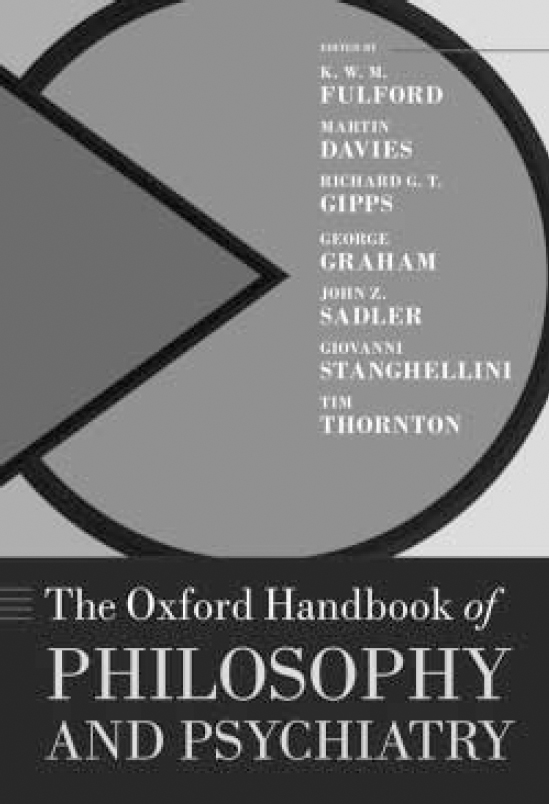
Over 1300 pages long, comprising 73 chapters and featuring 90 authors, this is a massive book. Its sheer size alone is daunting, and when the editors breezily announce in the introduction that the text is primarily ‘by philosophers for philosophers’, one quakes a little at the prospect of actually reading it. The volume certainly assumes a sophisticated knowledge of philosophy on the part of the audience with much of the writing dense and technical. However, if one is selective - and the editors make the task of circumnavigating the book easier by providing short summaries at the start of each of the eight sections - there are many chapters which are not only accessible to the non-expert but also of direct relevance to clinical practice.
George Graham begins his chapter on models of madness with the story of ‘the man who aimed to compose… the Conjunction Theory of Mental Disorder’ by combining every theory ever proposed. Graham uses humour to demonstrate that any attempt to erect a grand, all-encompassing explanation of psychiatric illness is doomed, because not only are competing theories often incompatible, but we have to discriminate between the plausible and the absurd. Eric Matthews draws on the work of the French philosopher Merleau-Ponty to elegantly undermine the notion that psychiatry has to choose between being either exclusively ‘mindless’ or ‘brainless’. Matthews argues that Merlau-Ponty’s contention that human beings are ‘embodied subjects’ helps us to see that we need both the neurosciences and psychology in psychiatry.
In their discussion of the phenomenology of delusions, Louis Sass and Elizabeth Pienkos consider Bleuler’s notion of ‘double bookkeeping’. Many patients seem to be able to live simultaneously in their deluded world and in the world of the sane without being unduly troubled by the apparent contradictions. Like Jaspers before them, Sass and Pienkos wonder why patients seldom follow through the implications of their delusions: for example, why is the man who believes he is God still content to sweep the hospital floor? In an attempt to understand this phenomenon, they evoke the much-used analogy of madness as a dream: in sleep, we passively give ourselves over to the absurdities of the unconscious and yet we are aware that we are dreaming.
The psychiatrist Hanna Pickard has a thoughtful chapter on personality disorder which she sees as a ‘disorder of agency’. She argues that clinicians have to maintain that such patients are responsible for their actions, but, at the same time, avoid the seemingly logical step of blaming them when they falter. Denying that these patients have some degree of responsibility defies common sense, while blaming such individuals, who are often plagued by low self-worth, can be therapeutically damaging. A response by a patient, Lisa Ward, at the end of the chapter affirms that the type of approach advocated by Pickard was the one she found most helpful when she was in therapy.
Another contribution from someone who has direct experience of psychiatric problems is that by the philosopher and self-confessed alcoholic, Owen Flanagan. In one of the most interesting chapters in the book, he provides an existential perspective on addiction in which he portrays the individual as choosing the identity of the alcoholic, rather than being the passive victim of biological forces. This has consequences for treatment: it is not just a matter of the alcoholic abstaining; they have to develop a new mode of being in the world, they have to become a different person.
Towards the end of the book, Richard Askay and Jensen Farquhar compare the work of two men they consider to be the ‘greatest ‘’meta-physicians” of the twentieth century’: Freud and Heidegger. These thinkers are not usually bracketed together, but the authors contend that, despite their intellectual antipathy, there are many similarities in their metaphysical approach. Both Freud and Heidegger sought to develop a comprehensive, unified account of the human condition. Both tried to uncover life’s hidden meaning while accepting that there was probably not a deep, unifying meaning to human existence. Both tried to develop a new ‘science of the human being’ which would inform a new type of psychotherapy, in the case of Heidegger, existential analysis, in Freud’s, psychoanalysis.
The editors note that their book appears exactly 100 years after psychiatry’s first philosopher, Karl Jaspers published General Psychopathology. They are justified in their claim that this volume makes a major contribution to the tradition that Jaspers instigated. The involvement of practically all the major thinkers in the field and the sheer range of subjects covered makes this publication an impressive achievement.



eLetters
No eLetters have been published for this article.